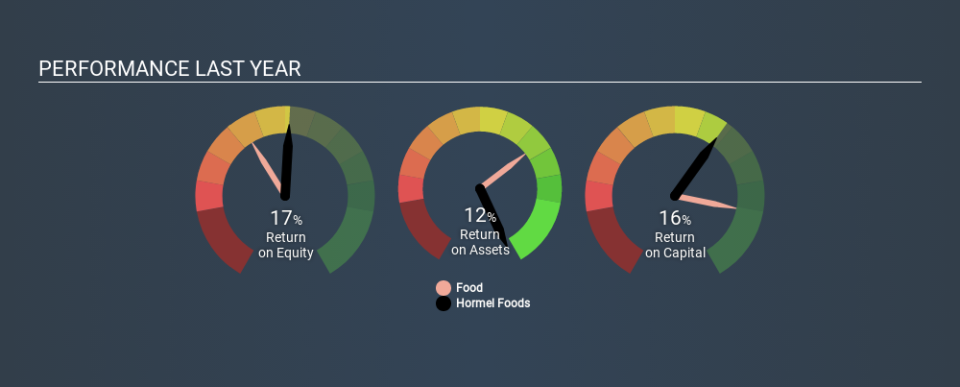Why You Should Like Hormel Foods Corporation’s (NYSE:HRL) ROCE

Today we'll look at Hormel Foods Corporation (NYSE:HRL) and reflect on its potential as an investment. To be precise, we'll consider its Return On Capital Employed (ROCE), as that will inform our view of the quality of the business.
First of all, we'll work out how to calculate ROCE. Next, we'll compare it to others in its industry. Finally, we'll look at how its current liabilities affect its ROCE.
Understanding Return On Capital Employed (ROCE)
ROCE measures the 'return' (pre-tax profit) a company generates from capital employed in its business. All else being equal, a better business will have a higher ROCE. In brief, it is a useful tool, but it is not without drawbacks. Author Edwin Whiting says to be careful when comparing the ROCE of different businesses, since 'No two businesses are exactly alike.
How Do You Calculate Return On Capital Employed?
Analysts use this formula to calculate return on capital employed:
Return on Capital Employed = Earnings Before Interest and Tax (EBIT) ÷ (Total Assets - Current Liabilities)
Or for Hormel Foods:
0.16 = US$1.1b ÷ (US$8.1b - US$1.1b) (Based on the trailing twelve months to October 2019.)
So, Hormel Foods has an ROCE of 16%.
Check out our latest analysis for Hormel Foods
Does Hormel Foods Have A Good ROCE?
One way to assess ROCE is to compare similar companies. In our analysis, Hormel Foods's ROCE is meaningfully higher than the 9.2% average in the Food industry. We consider this a positive sign, because it suggests it uses capital more efficiently than similar companies. Independently of how Hormel Foods compares to its industry, its ROCE in absolute terms appears decent, and the company may be worthy of closer investigation.
Hormel Foods's current ROCE of 16% is lower than its ROCE in the past, which was 24%, 3 years ago. Therefore we wonder if the company is facing new headwinds. The image below shows how Hormel Foods's ROCE compares to its industry, and you can click it to see more detail on its past growth.
When considering ROCE, bear in mind that it reflects the past and does not necessarily predict the future. ROCE can be misleading for companies in cyclical industries, with returns looking impressive during the boom times, but very weak during the busts. ROCE is only a point-in-time measure. Since the future is so important for investors, you should check out our free report on analyst forecasts for Hormel Foods.
Do Hormel Foods's Current Liabilities Skew Its ROCE?
Liabilities, such as supplier bills and bank overdrafts, are referred to as current liabilities if they need to be paid within 12 months. Due to the way the ROCE equation works, having large bills due in the near term can make it look as though a company has less capital employed, and thus a higher ROCE than usual. To counteract this, we check if a company has high current liabilities, relative to its total assets.
Hormel Foods has total liabilities of US$1.1b and total assets of US$8.1b. As a result, its current liabilities are equal to approximately 14% of its total assets. Low current liabilities are not boosting the ROCE too much.
Our Take On Hormel Foods's ROCE
With that in mind, Hormel Foods's ROCE appears pretty good. Hormel Foods looks strong on this analysis, but there are plenty of other companies that could be a good opportunity . Here is a free list of companies growing earnings rapidly.
I will like Hormel Foods better if I see some big insider buys. While we wait, check out this free list of growing companies with considerable, recent, insider buying.
If you spot an error that warrants correction, please contact the editor at editorial-team@simplywallst.com. This article by Simply Wall St is general in nature. It does not constitute a recommendation to buy or sell any stock, and does not take account of your objectives, or your financial situation. Simply Wall St has no position in the stocks mentioned.
We aim to bring you long-term focused research analysis driven by fundamental data. Note that our analysis may not factor in the latest price-sensitive company announcements or qualitative material. Thank you for reading.



